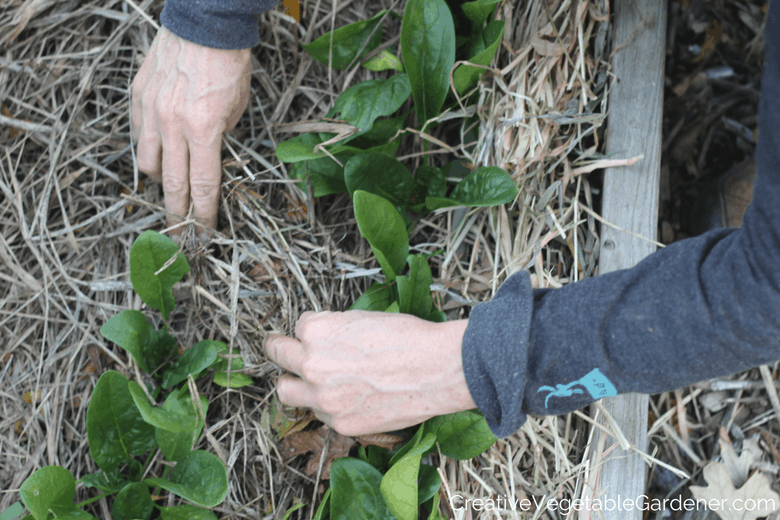
When the cooler weather of fall arrives most of us dig out our chunky sweaters, queue up our gloves by the front door, and search for our missing stocking cap which hasn’t been seen since last spring.
Why do we automatically do these tasks? Because it’s time to cover up for winter.
You wouldn’t go outside barely dressed – say in shorts and flip flops – on a windy, frozen winter day. You’ll choose to protect yourself from the harsh weather instead.
Well, guess what? You need to do the exact same thing for your garden soil.
As your garden heads into its dormant season, you need to cover it up for winter with a little fall mulching.
Here’s why and how and everything else you need to know!
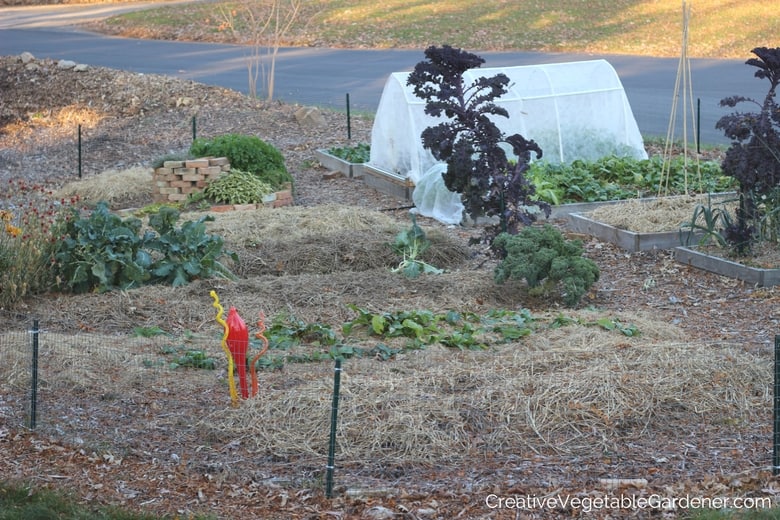
My front yard garden mulched and ready for winter.
This post contains affiliate links.
How Fall Mulching Can Improve Your Garden
In my article on how to prepare your garden for winter, I share that one of the most important things you can do for your garden is to mulch all of your garden beds before you pack away your garden tools for the winter.
We’re specifically talking about fall mulching of garden beds in this article, although I do recommend also keeping your paths mulched as well. I’ll share more about that at the end of this post.
And in fact, you should really be mulching all season long. My philosophy is — no bare soil in the garden unless I’m waiting for seeds to geminate.
But, although I mulch my garden heavily most of the year, I do find that by the time the end of the season rolls around much of that mulch has broken down and needs to be replenished.
Here are the top reasons why you should mulch your garden, not only in the fall, but all year round!
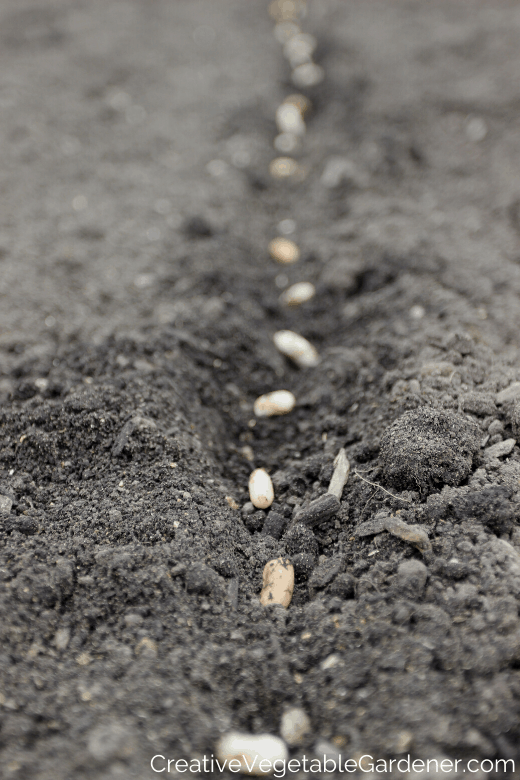
#1: Protect the soil.
The harsh winds and freezing temperatures of winter in cold areas can be quite damaging to exposed soil, causing compaction and erosion from the wind. In warmer areas that experience rain instead of snow, bare soil can erode and wash away.
By the time spring arrives, soil left uncovered could be eroded, compacted, or extremely dried out. Because soil health is one of the biggest factors of a successful garden, you do not want to start off the season with damaged soil.
That’s why fall mulching is a critical task to complete before you shut your garden down for the season.
Before mulching, it’s a good idea to clear out and dispose of at least some of your plant debris, especially if you had disease and pests this past season. I share six tasks you should be doing to prepare your garden for winter, including which plants to cut down and which to leave up for insects, birds, and other wildlife.
So, your first step should be cleaning up spent plant debris, and then you’ll put on a thick layer of mulch for the winter.
How thick? Keep reading…
Your goal should be to have no bare soil in your garden as winter arrives. This is why fall mulching is so important.
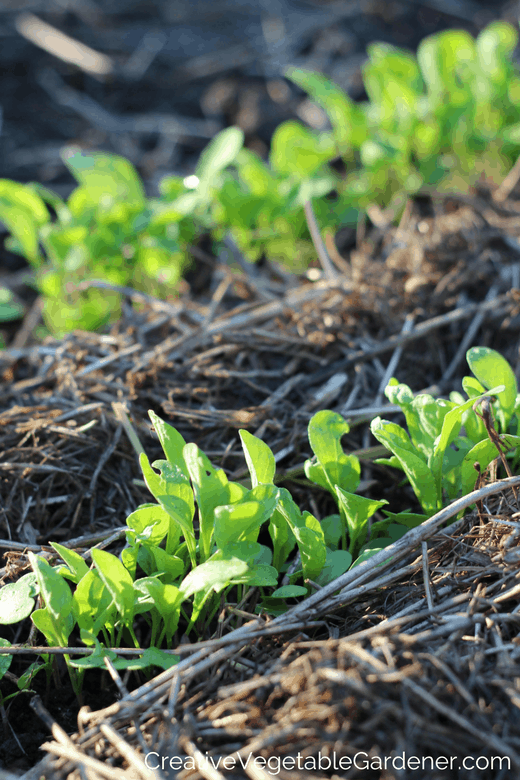
#2: Trap in soil moisture.
As I stand here at my desk writing this article, it’s been raining outside and really saturating my garden. We’ve had an incredibly dry summer here in Madison, WI where I live. As I’ve been checking off the items on my fall cleanup list I’ve noticed that the soil in my garden beds is disturbingly dry.
Luckily, we often get some fall rains here before the ground freezes. Keeping a layer of mulch on your garden will trap in any of the soil moisture that’s already there and encourage any additional moisture in the form of rain to stick around.
The harsh and cold winter winds have a tendency to desiccate, or dry out, any soil that’s exposed in your garden. It’s better for soil and plant health to have moist, but not wet, soil.
One of the best ways to preserve soil moisture is to keep it covered.

#3: Fewer weeds in spring.
The added benefit of getting all of your soil covered with fall mulching is that you’re setting yourself up for much less work in spring.
Why? Because plant growth really explodes and starts to accelerate as the soil warms, the spring rains arrive, and the sun grows stronger. Weeds sprout and grow quickly in the beginning of the spring gardening season.
Sometimes, you may find that you have a crop of weeds going strong before you even get to planting your first vegetables of the year.
If you have a tendency to put off spring planting and gardening tasks because you get busy, then the mulch you lay down in fall will keep those early spring weeds at bay until you get a chance to dig out your gardening tools.
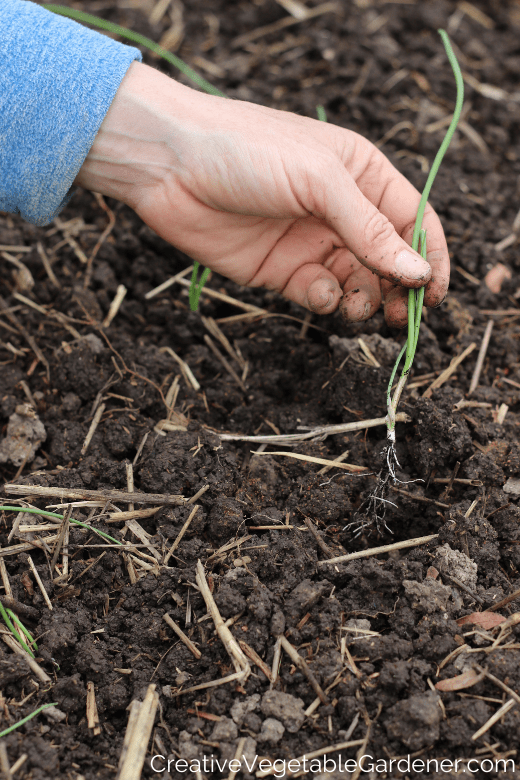
#4: Build healthy soil.
You may have heard that as an organic gardener you should try to build up the organic matter in your soil. It helps supply plants with the nutrients they need, improves soil structure, helps retain moisture, and increases the number of soil microorganisms.
Organic matter is mostly created by decomposing plant debris. The materials we use for mulch, like straw, leaves, or grass clippings, will break down over time and help increase the organic matter of your garden soil.
This is one of the building blocks of creating healthy soil in your garden.
If you’re concerned that your soil isn’t as healthy as it should be or your plants aren’t growing as big as your neighbor’s, then you might need to work on your soil. Read about six reasons you might be having soil problems.

My spring garden is mulched and tidy. Not many weeds here!
#5: Neat and tidy.
True confession time! I’m an organized and tidy person. It you happened to live near me and walked past my garden this would be very apparent.
My garden is a beautiful riot of color and texture, but some of its gorgeousness comes from the fact that it has an overall structure and organization to it.
This part of my personality really likes to savor my fall cleanup at the end of the season. I wait for warm and sunny days and treat myself to a few hours of garden deconstruction time after work or on the weekend.
It’s fun getting everything in order and ready for the next season ahead of time. And the springtime you will thank the fall you next year!
Fall mulching and clean up will help you experience an immense satisfaction at the end of the process. When all of your garden beds are tucked in for the winter with a thick layer of straw or hay to keep them cozy, you’ll feel like the season is complete. Time to hibernate!
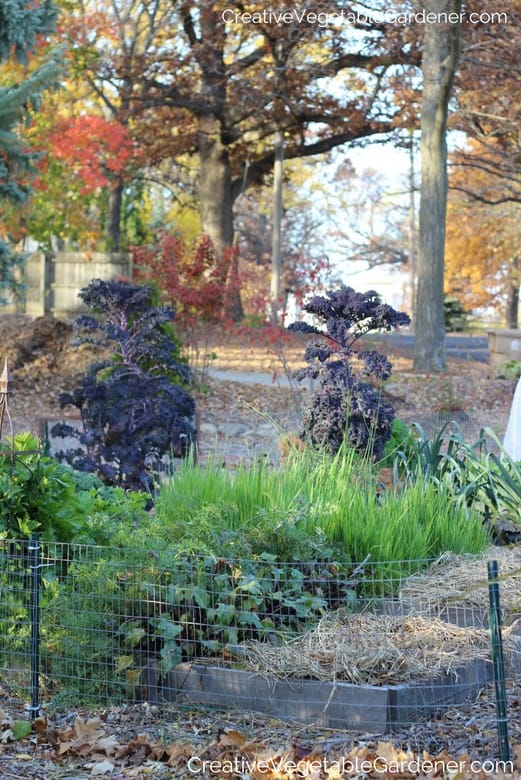
What should you use for mulch?
There are several choices when it comes to selecting a fall mulch for your garden beds. Here are a few things to think about.
Hay – Marsh hay is my first choice for mulch in my garden. You do need to be careful of using hay because it can be sprayed with chemicals or contain noxious weed seeds. I trust my source and I’ve never had any issues with my hay bales over the last 15 years.
I purchase mine from a local garden center (Jung’s) and I know the person who harvests and sells the hay. Searching on Craigslist in your town or asking local farmers at the market are other potential sources.
Straw – When I can’t find marsh hay, straw is my back up mulch for garden beds. Straw is a byproduct of grain crops, so is often barley, wheat or oat straw, depending on where you live.
It can still have some seeds of the crop in the bale. If it’s a mild fall you might notice some sprouts coming out of the straw, either when it’s in bale form or spread over your bed.
This happens to me when I use oat straw. The sprouting plants look like blades of grass. To confirm they’re straw, you can pluck a sprout from the straw and look for a little oat seed at the other end.
Oats and barley plants don’t survive the winter in cold areas, so it’s not an issue if they send up some sprouts in the fall.
Rye can survive the winter and start re-growing in the spring. Once it roots into your garden bed it can be tough to get rid of, so try to source oat or barley straw instead, or monitor your rye straw to make sure it’s not trying to establish residency in your garden.
I purchase my straw at a local garden center (Jung’s). Searching on Craigslist in your town or asking local farmers at the market are other potential sources.

Leaves – If you have a lot of trees on your property, instead of raking and bagging your leaves for collection in the fall you can spread a layer over your garden beds instead.
I’ve found that whole leaves have a tendency to mat together and prevent water from getting to the soil, so we compost our leaves first in the back corner of our yard and then use them the following season.
You can also use a mower to chop them up before layering them on your garden.
Leaves break down a lot more quickly than hay or straw, so you might want to have some back up mulch handy for the next spring and summer. I often spread leaf mulch on a garden bed and then cover it with a layer of hay.
Grass clippings – As long as you don’t spray chemicals on your lawn you can use your grass clippings as mulch for your garden beds. Like leaves they break down quickly, so you might want to use them underneath hay or straw as an added layer.
Caution! Mind your source of mulch. Anything you purchase and bring on to your property can introduce unwanted visitors like noxious weed seeds or chemicals into your garden if you’re not careful. Ask questions about where the mulch came from before you purchase it.
Smart tip: If you’re unsure whether a bale of straw or hay contains weed seeds, leave it out in the rain for a few weeks, or the whole season, and watch to see if anything starts to sprout out of it.
And before we end this section, let’s talk about woodchips for a sec.
I don’t recommend using woodchips for mulching of vegetable garden beds because they contain a lot of carbon. When carbon heavy materials get mixed into the soil and start to break down, they tie up a lot of nitrogen that would otherwise be going to the vegetable plants.
I’ve seen stunted vegetable plants in my and other peoples’ garden from an excessive use of woodchips as mulch around vegetable plants.
You can do it successfully, but it requires a lot of monitoring of your soil fertility, so I suggest just skipping woodchips as mulch on your garden beds.
But! You can definitely use them in your aisles and I do…liberally! Every spring, my arborist husband drops a huge load of woodchips in our driveway and I get my spring exercise by running wheelbarrows back and forth to my vegetable garden to spread a thick layer on my paths.
I hate weeding, so I always keep my garden paths covered in mulch as well.
How thick should you mulch?
As a huge proponent of mulching, I always joke that in my book there’s no such thing as too much mulch. Basically, you want to make sure you can’t see any soil through the mulch once you’ve placed it on your garden bed.
If you live in a very wet climate or struggle with snails and slugs in your garden you may want to go a bit easier on the mulch.

How I use mulch in my garden.
My strategy with mulch is this – I never have bare soil in my garden unless I’m waiting for seeds to geminate. This means I do very little weeding throughout the season, have nice moist soil even during the heat of summer, and my garden beds are teaming with microbes and fungi.
In fall, as part of my garden clean up, I top any empty beds off with a little leaf compost and a thick layer of straw or hay for the winter.
In spring, I usually don’t need to add more mulch onto my garden beds since it doesn’t really break down over the winter. But, I will buy a few bales to have on hand just in case.
I stack them in the back of my yard, sometimes covered with a tarp and sometimes not. I don’t mind when they get wet and start to break down. I find them easier to spread when they’re partially decomposed.
I pull mulch from this pile throughout the season when I notice a bed that needs an additional application.
At the beginning of the gardening season, I tend to focus on my garden paths because my beds are usually pretty well covered from my fall mulching. I definitely don’t want weeds growing in my paths throughout the season. So, I spread 4-5 inches of woodchips over my entire garden.
Let me stress it again – there’s absolutely no reason you need to be spending hours weeding your spring garden. If you take some time for fall mulching so the soil is covered for the following year, you shouldn’t have many weeds at all.
This will make your spring garden prep a breeze! You’ll spend a lot more time focusing on fun tasks like planting and sowing, and less time toiling in the garden pulling weeds.
So, before you pack away your garden gloves, challenge yourself to clean out at least a portion of your garden and spend a Saturday crossing fall mulching off your garden task list. You won’t regret it!

Additional Resources for Fall and Winter Gardening
GARDEN SUPPLIES
You can find my favorite garden tools, supplies, books, and more in my Amazon storefront.
BLOG ARTICLES
You can find all of my articles about fall gardening here.
All of my winter gardening posts are on this page.
And the most popular posts from this time of year are:
SHARE IT ON PINTEREST

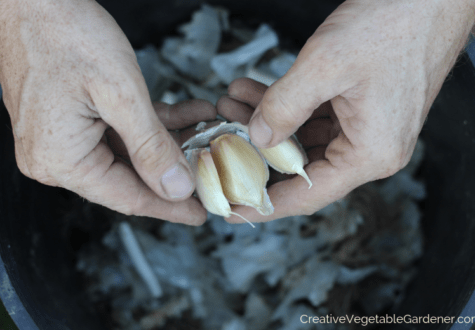





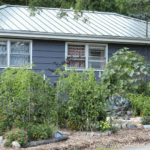
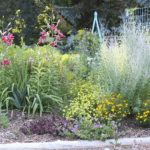
Comments
Can you provide some local resources for finding marsh hay? The ones I have found are close to $5 a bale which is too cost prohibitive for the quantity I need for my garden/yard. I’d be happy to pay for a delivery!
Thanks!
Hi Elaine- I don’t know anywhere in Madison that sells bales for less than $5 each. I would look on Craigslist to see if you can find someone outside of the city who would sell a large quantity. Be VERY careful about your source, make sure you’re not importing more weeds into your garden. Ask questions about what kind of hay or straw it is. Good luck!
What do you think about mulching and pests? I mulch, but this year I had a terrible time with squash bugs. Too many bugs on too many plants to kill by hand. I ended up pulling the winter squash early because of them.
Resources that give suggestions on avoiding squash bugs say to remove all debris from the ground (including mulch). I don´t really like that idea, but these bugs drove me crazy this year! And I after this year´s battle I swore that I would not grow squash next year, but I know I love squash too much to do that. What are your thoughts?
Squash bugs can be such a pain! I’m sorry to hear you had such troubles. As far as mulch and pests, I think it all depends on the pest. Squash bugs overwinter outside of your garden in more wooded areas, so mulching for winter shouldn’t affect them either way. As for during the season, they do like to gather at the base of the squash plants, so you could clear away the mulch there to make them easier to see. Have you tried floating row cover? This seems to be the best tactic I’ve read about, although you have to remove it when the plant starts to really flower so it can be pollinated. I gave up on cucumbers at my old house because the pests were so bad. Sometimes that’s what it takes, even though it’s really disappointing.
If I mulch my raised garden beds with leaves this fall what do I do with all the mulch in the spring? Thanks…Mike
Great question, Mike! If I’m planting seedlings in spring I just make a space in the mulch and dig a hole for the seedling. I keep my beds mulched all year round. If I’m planting seeds I’ll clear off the bed, plant the seeds, and then mulch them again once they get to be a bigger size.
what is planted in the hoop house in your garden picture? I tried covering my collards this year with row cover but the cabbage moth got at them anyway. Any ideas to protect from cabbage moth?
Kathy- I have kale under the row cover. I, too, have very bad problems with cabbage moths and this has been very effective. I didn’t have any damage from them this year on the kale under cover. The plants outside the row cover got destroyed! My guess is that you left your row cover too loose so the moth got underneath. I really batten down the hatches on mine with some pins. You could also use logs or rocks. I’d try again next year because this has been the most effective technique for me!
is it best to wait for a hard frost before mulching? I don’t want the weeds growing under the protection of mulch, especially in strawberry and asparagus beds
Hi Jean- I keep my beds mulched all year round, so you can mulch at any time. If you already have weeds in those beds I’d pull them and then mulch. Unless they’re really small and you live in a very cold climate where they’re likely to die even under some mulch. Or, you can wait until a hard frost, but usually it’s not as fun to work in the garden by that time! I did some light weeding yesterday in my garden and then spread more hay on most of my beds. It was 70 degrees F!
Do you till in the fall before you mulch ?
Hi Gary- I don’t recommend tilling your garden. It’s bad for the soil structure and it creates more work in the long term. Here’s a post I wrote about it: https://www.creativevegetablegardener.com/stop-tilling-vegetable-garden-2/ Thanks for stopping by!
[…] This is such an important step that I dedicated an entire blog post to it. […]
How do I keep my mulch from blowing away?
Hmmm, sounds like you live on a windy site, Sheri. If you’re using hay or straw you could leave it out for a few months in the rain so it starts to break down. This may help it not blow around as much since it won’t be as dry. At a client’s garden that was really windy I ended up lining the fence with burlap to try to cut down on the wind. Good luck!
It’s been 2 years that haven’t have luck with zucchini. They flower, have little zucchini after that it just rot. First year was lucky had too much and ended up giving away to friends. What mistake have I done to not harvesting any
I’ve never mulched my garden in the winter, but I’m going to do it this year for the first time to see how it impacts the garden come spring. You’ve laid out plenty of great reasons to do it! Also, I too use marsh hay from Jungs (I used to get it from Kleins for years, but Jungs seems to always have it in stock where it was hit or miss at Kleins- both great garden centers).